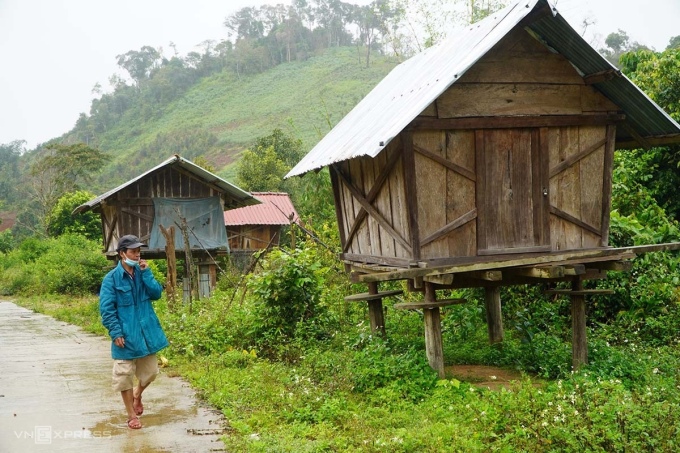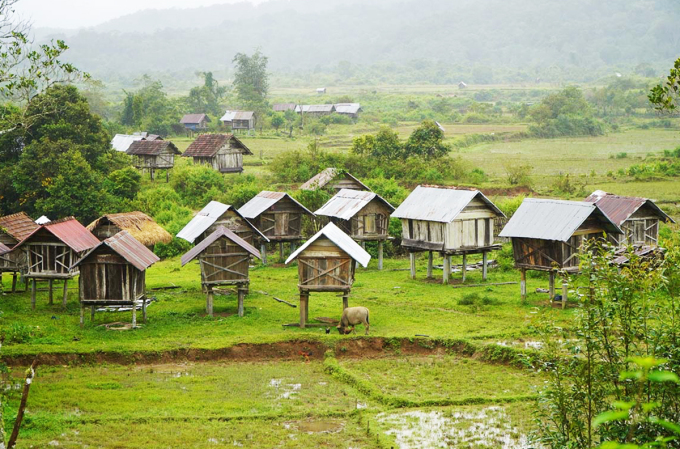Bana ethnic community celebrates new crop
Celebrating a new harvest season is one of the biggest events of the year for the Ba Na ethnic minority in
GIA LAI – After the harvest, the rice is brought by the Ba Na and Jarai to be stored in warehouses in the middle of the field, on the fields, or next to the house, to avoid rat damage.
In the last days of November, Mr. Ke (58 years old) in Kon Bong village, Dak Rong commune, K’Bang district, carrying a bag on his back, holding a key in his hand, went to the barn about 200 meters away from his house. The Ba Na man slowly walked up the stairs, unlocked the door, and filled the basket with rice.
“Today, the family ran out of rice, had to bring rice to grind to prepare dinner,” Mr. Ke said and revealed that the house had two granaries, a larger one in the field. In the last crop, the family’s 3-acre garden obtained 50 bags (30-40 kg each), enough for the whole family to eat throughout the year, part of it was sold to cover living expenses.
Like other ethnic groups in the Central Highlands, each Ba Na family has 1-2 granaries depending on the amount of rice harvested in a season. The warehouse is designed like a house on stilts, but smaller, with a width of 5-10 m2, thatched roof, walls made of wooden planks or woven bamboo sheets, preventing rice from falling out but still keeping ventilation. Many warehouses with corrugated iron roofs and wooden pillars were replaced with concrete.
In the middle of the barn’s feet are 4 round boards or greased with lubricating oil so that rats and squirrels do not climb up to bite and destroy the rice. These granaries were erected next to the house, in the field, or in the fields a few kilometers away. The harvested rice is dried by people before being stored.
The Ba Na people believe that rice also has a governing god and that the rice god has given people food and health. Therefore, each year Mr. Ke’s family organizes the worship of the rice warehouse twice – before taking out the seed to plant a new crop and after the harvest is complete, with the hope of a bountiful harvest.
On the day of sacrifice, Mr. Ke chooses the most delicious rice grains to cook rice for the gods and uses chicken blood to smear on the corners of the four legs and the lock of the granary. Homeowners plant 3 fresh bamboo tops in front of each storehouse with the meaning that the god of rice will reside and govern the barn for them.
According to Mr. Tam, head of Kon Bong village, Dak Rong commune, K’bang district, 150 households in the village, every house has a granary, few people have one, many rice two. “Looking at the number of granaries more or less, large or small, one can also guess the well-being of that family,” said Mr. Tam.
To the head of Kon Bong village, the granary is meant to protect the results and hard work of the whole year farmers, preventing rats and other animals from destroying.
“Recently, many granaries have been stolen, so families have to use door locks,” said Mr. Tam, adding that in the past, the village law stipulates that if anyone is found stealing rice, they will be fined pigs and chickens, so the rice is never banned. thieves.
They also do rice storage similar to many ethnic groups in the Central Highlands, but the Jarai people have the concept that food is given by the gods (Yang), so people and rice cannot live together.
The concept of the Jarai people, people have a house to live in, the rice must also have a warehouse. If the storage is not proper, Yang will be angry and will not give a good harvest. When the rice is harvested, it will be eaten by birds, worms, and squirrels in the forest, and the villagers will go hungry.
Every November, the Jarai people often hold a ceremony to celebrate new rice at the beginning of the harvest season. But now, in many places, people know how to make two crops of wet rice, so in addition to the new rice offering ceremony in each family, the scale and time of the organization and the offerings are somewhat simplified.
Offerings include rice, wine, chicken, and a family that has good conditions for offering sacrifices, which can be reduced by those in difficulty. When taking rice to grind and pound to make rice, the Jarai people have to ask permission from Yang and the gods because rice is a precious product, no one can waste it… Follow vnexpress


